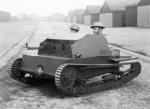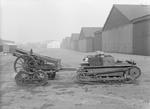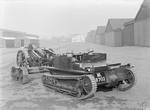Carden Loyd
| Country | United Kingdom |
| Manufacturer | Vickers-Armstrongs, Limited |
| Primary Role | Tankette |
Contributor: Alan Chanter
ww2dbaseMr. (later Sir) John Carden was an engineer who, in the late 1920s was running a garage in London, England, United Kingdom owned by a Mr. Vivian Loyd. Carden had already designed and produced a popular cycle-car and then designed a light tracked vehicle with the intention of enhancing the mobility of infantry. In 1925 a one-man prototype was demonstrated which was followed by the Mark I version which simply added a steel box around the occupant. At this time there was considerable interest in vehicles that could move on tracks across country but on wheels on roads. The Carden-Loyd Mark I, therefore, was fitted with two large road wheels on each side and a third at the rear for steering. In late 1926 the War Office ordered eight of the wheel-and-track machines, but by then Carden-Loyd had produced a two man tankette running on tracked suspension on rubber-tyred bogies. The supplied machines were subsequently modified with the same suspension arrangement and re-designated Mark V. Armed with a Vickers machine-gun and protected with 9-millimeter armour plate these vehicles were employed for trials by the Experimental Mechanized Force formed in 1927.
ww2dbaseIn 1928, Vickers-Armstrong bought out the firm Carden-Loyd Tractor, Limited. John Carden moving to Vickers as a designer and under his supervision a fresh design, the Mark VI, was developed with improved suspension, additional armour, and improved storage space. The Mark VI would become the design's final variant. A large majority of these vehicles were sold to the British Army for use as machine gun carriers, gun tractors, mortar carriers, or smoke projector vehicles, but it was worthy to note that the British Army rejected them for use in the role of light tanks. Their popularity with British forces subsequently led to the design's evolution into the widely employed Universal Carrier.
ww2dbaseThe design received warmer reception both as a personnel carrier as well as a combat vehicle. 10 or 11 Mark VI tankettes were sold to Poland in 1929 (with a license to develop their own design), 3 Mark VI tankettes were sold to Czechoslovakia in 1930 (also with license for further development), 20 Mark VI tankettes were sold to the Soviet Union (also with a license for further development), about 5 were sold to Bolivia in 1931 (saw action in the 1932-1935 Chaco War), 6 Mark VIb tankettes were sold to Japan, an unknown number of Mark VI tankettes were sold to Italy (with license for further development), 12 were sold to Canada between 1930 and 1931, 18 Mark IV tankettes were sold to Latvia in 1935, 5 were sold to the Netherlands, 6 were sold to Belgium, 60 were sold to Thailand, 2 were sold to China, 6 were sold to Portugal, a few were sold to Finland, a few were sold to France, a few were sold to India, a few were sold to Greece, a few were sold to Chile.
ww2dbaseThe first Carden Loyd tankettes to see action in WW2 were the Finnish-operated vehicles, having seen fighting during the 1939-1940 Winter War against the Soviet Union. Then, the Dutch- and Belgian-operated vehicles saw fighting against the Germans during the invasion of May 1940. The tankettes operated by Thai forces fought against French and French colonial forces during the 1940-1941 Franco-Thai War.
ww2dbaseProduction for these vehicles, across all variants, took place at Carden-Loyd/Vickers-Armstrong between 1927 and 1935; after 1935, production was shifted to Royal Ordnance Factories. About 450 examples were built.
ww2dbaseSource: Wikipedia
Last Major Revision: Feb 2018
SPECIFICATIONS
Mark VI
| Machinery | One Ford Model T petrol 4-cyl engine rated at 22.5bhp |
| Suspension | Bogie |
| Armament | 0.303in Vickers machine gun (1,000 rounds) |
| Armor | 6-9mm |
| Crew | 2 |
| Length | 2.46 m |
| Width | 1.99 m |
| Height | 1.22 m |
| Weight | 1.5 t |
| Speed | 48 km/h |
| Range | 160 km |
Photographs
 |  |  |  |
Did you enjoy this article or find this article helpful? If so, please consider supporting us on Patreon. Even $1 per month will go a long way! Thank you. Share this article with your friends: Stay updated with WW2DB: |
- » WW2DB's 20th Anniversary (29 Dec 2024)
- » Wreck of USS Edsall Found (14 Nov 2024)
- » Autumn 2024 Fundraiser (7 Nov 2024)
- » Nobel Peace Prize for the Atomic Bomb Survivors Organization (11 Oct 2024)
- » See all news
- » 1,150 biographies
- » 337 events
- » 44,024 timeline entries
- » 1,242 ships
- » 350 aircraft models
- » 207 vehicle models
- » 375 weapon models
- » 123 historical documents
- » 260 facilities
- » 470 book reviews
- » 28,597 photos
- » 432 maps
Winston Churchill
Please consider supporting us on Patreon. Even $1 a month will go a long way. Thank you!
Or, please support us by purchasing some WW2DB merchandise at TeeSpring, Thank you!